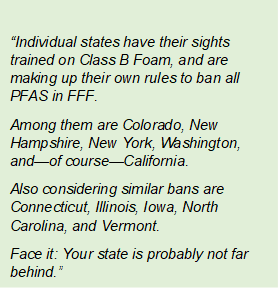Pegex: Hazardous Waste Disposal of Class-B Firefighting Foam
There are two scenarios in which you might need to dispose of firefighting foam (FFF).
By far the happier of the two is when you need to get rid of some unused quantity because you’ve never had anything happen on your premises that were of immediate interest to the local fire department, and so the FFF is past its best-if-used-by date.
Decidedly less happy is the circumstance wherein you have hundreds of gallons of spent FFF splashed about your premises, having been used to extinguish some sort of unwanted conflagration, and that might require hazardous waste disposal, depending on your locality.
There are two classes of FFF
The first thing you need to know about FFF-disposal is what kind you’re dealing with. There are two:
- Class A Foam reduces the surface tension of any water it’s mixed with, allowing it to cling to vertical surfaces without running off. Dispensed by compressed air onto burning wood, paper, and brush, it’s widely used by fire departments to stop buildings from burning down. But it’s useless on flammable-liquid fires because oil, gasoline, etc. will simply float atop the foam and spread the fire—which is why there’s Class B Foam.
- Class A Foam can be made of non-corrosive, non-toxic, biodegradable materials, and thus be environmentally benign when it comes to disposal. So in many jurisdictions, Class A Foam is considered nonhazardous and may be hosed into the local sewer system. But you should check with local authorities, as some localities might have unique requirements. And there are other issues.
- Class B Foam is used to extinguish burning oil, gasoline, jet fuel, and other flammable liquids. Commonly referred to as AFFF for “aqueous film-forming foam,” it’s created by combining foaming agents with per- and poly-fluorinated surfactants (PFAS). These form an aqueous film when mixed with water, depriving a flame of oxygen, and thus extinguishing it. Unfortunately, however, PFAS is the polar opposite of “eco-friendly.”
- Per this source, credible research links PFAS to a wide range of health problems, including kidney and testicular cancers, endocrine disruptors, and perhaps greater susceptibility to infectious diseases. Lawyers accuse it of complicity in leukemia, lymphoma, neuroendocrine tumors, and a gaggle of different cancers. PFAS also doesn’t break down easily, so it can remain in the environment (and your body) for decades.
The EPA and PFAS
Given the egregious nature of PFAS, you might think that they would be a major blip on the EPA’s radar. And you would be correct. But the agency hasn’t gotten around to “final guidance,” although it’s on the cusp, as you can read here.
The EPA’s dilemma is that PFAS are ubiquitous in our daily lives, so a sudden & outright ban would be problematic.
PFAS are used in a myriad of products to repel water, grease, and stains. (E.g. nonstick pans, food packaging, waterproof jackets, and carpeting.) They also show up in personal care products. (E.g. waterproof mascaras, eyeliners, sunscreens, shampoos, and shaving creams.)
up in personal care products. (E.g. waterproof mascaras, eyeliners, sunscreens, shampoos, and shaving creams.)
As a result of their prevalence, according to the CDC, more than 95 percent of Americans have PFAS in their bodies.
Meanwhile, individual states have their sights trained on Class B Foam, and are making up their own rules to ban all PFAS in FFF. Among them are Colorado, New Hampshire, New York, Washington, and—of course—California.
Also considering similar bans are Connecticut, Illinois, Iowa, North Carolina, and Vermont.
Face it: Your state is probably not far behind.
FFF that’s labeled Class A might nonetheless contain PFAS.
Be careful. Per this source, it might not be easy to tell if the FFF on your premises contains PFAS. Since they’re not currently considered a hazardous substance, they aren’t required to be reported on any safety data sheets. Also, neither might PFAS be listed under active ingredients.
The upshot
Obviously, if you have FFF on your premises, depending on location, you either have an eco-liability on your hands…or you soon will. Thus, you need to develop a plan now, lining up a reputable hazardous waste disposal company to remove FFF from your premises, whether because it’s out-of-date, or (heaven forbid) spent.
Hazardous Waste Experts offer you decades of experience providing environmental solutions throughout the U.S. Our experts are constantly assessing the evolving local, state, and federal regulatory framework surrounding PFAS. As a one-stop solution for hazardous waste management, we’re uniquely qualified to help you manage your PFAS waste needs.
To know more, please check Pegex.

